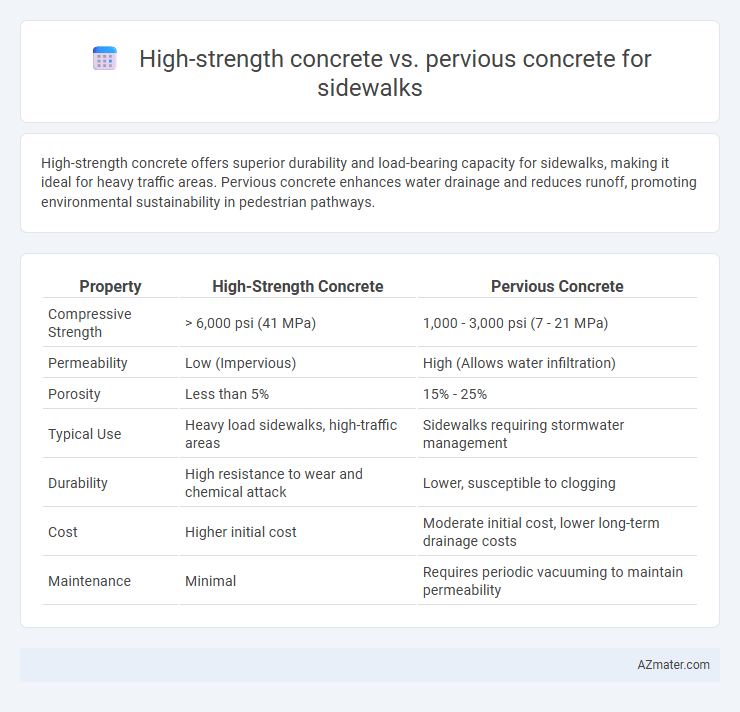High-strength concrete offers superior durability and load-bearing capacity for sidewalks, making it ideal for heavy traffic areas. Pervious concrete enhances water drainage and reduces runoff, promoting environmental sustainability in pedestrian pathways.
Table of Comparison
| Property | High-Strength Concrete | Pervious Concrete |
|---|---|---|
| Compressive Strength | > 6,000 psi (41 MPa) | 1,000 - 3,000 psi (7 - 21 MPa) |
| Permeability | Low (Impervious) | High (Allows water infiltration) |
| Porosity | Less than 5% | 15% - 25% |
| Typical Use | Heavy load sidewalks, high-traffic areas | Sidewalks requiring stormwater management |
| Durability | High resistance to wear and chemical attack | Lower, susceptible to clogging |
| Cost | Higher initial cost | Moderate initial cost, lower long-term drainage costs |
| Maintenance | Minimal | Requires periodic vacuuming to maintain permeability |
Understanding High-Strength Concrete: Properties and Uses
High-strength concrete typically has a compressive strength exceeding 6,000 psi, making it ideal for sidewalks requiring enhanced durability and load-bearing capacity. Its dense matrix reduces permeability, increasing resistance to wear and environmental damage, suitable for high-traffic pedestrian pathways. Used extensively in urban infrastructure, this concrete type supports longer service life and reduced maintenance compared to pervious concrete, which prioritizes water drainage over structural strength.
What is Pervious Concrete? Composition and Features
Pervious concrete is a specialized concrete designed to allow water to pass through its porous structure, reducing runoff and improving groundwater recharge. It is composed primarily of cement, coarse aggregates, little to no fine aggregates, and water, creating interconnected voids that provide permeability. Key features include high porosity (typically 15-25%), enhanced stormwater management, and environmental benefits, making it ideal for sustainable sidewalk construction compared to high-strength concrete, which prioritizes compressive strength but lacks permeability.
Key Performance Metrics for Sidewalk Materials
High-strength concrete offers superior compressive strength, typically exceeding 6,000 psi, making it ideal for sidewalks subjected to heavy pedestrian traffic and occasional vehicular loads, ensuring long-term durability and minimal maintenance. Pervious concrete, characterized by its high permeability rate of 100 to 1,000 inches per hour, enhances stormwater management by allowing water to pass through, reducing runoff and improving groundwater recharge, though it generally exhibits lower compressive strength around 2,500 to 4,000 psi. Factors such as load-bearing capacity, permeability, and resistance to freeze-thaw cycles are critical when selecting between these materials for sidewalk applications.
Strength and Durability: A Comparative Analysis
High-strength concrete offers superior compressive strength typically exceeding 6000 psi, making it ideal for sidewalks subjected to heavy loads and high traffic, ensuring long-term durability and resistance to cracking. Pervious concrete, designed with a porous structure to allow water infiltration, generally exhibits lower compressive strength around 2500 to 4000 psi but compensates by reducing surface runoff and promoting environmental sustainability. The trade-off between strength and permeability highlights that high-strength concrete prioritizes durability under mechanical stress, whereas pervious concrete emphasizes hydrological benefits with moderate durability, influencing material selection based on specific urban infrastructure needs.
Water Permeability and Drainage Capabilities
High-strength concrete offers superior compressive strength ideal for heavy loads but exhibits low water permeability, limiting its drainage capabilities on sidewalks. Pervious concrete, designed with interconnected voids, allows water to infiltrate quickly, significantly enhancing stormwater management and reducing surface runoff. Choosing pervious concrete for sidewalks improves water drainage and mitigates flooding risks, whereas high-strength concrete prioritizes durability over permeability.
Environmental Impact and Sustainability Factors
High-strength concrete offers superior durability and reduced maintenance for sidewalks, minimizing resource consumption over time, while pervious concrete enhances stormwater management by allowing water infiltration, reducing runoff and mitigating urban heat island effects. The production of high-strength concrete generally involves higher cement content, contributing to increased carbon emissions, whereas pervious concrete typically requires less cement and incorporates recycled materials, promoting sustainability. Selecting pervious concrete supports groundwater recharge and reduces environmental impact, making it a favorable choice for eco-friendly sidewalk construction.
Installation Processes: Techniques and Challenges
High-strength concrete sidewalks require precise mixing, placement, and curing techniques to ensure durability, often involving vibration and careful formwork to prevent cracking under load. Pervious concrete installation demands specialized procedures for maintaining aggregate uniformity and open pore structure, including controlled water content and minimal compaction to maximize permeability. Challenges in high-strength concrete include achieving target compressive strength without compromising workability, while pervious concrete installation struggles with clogging risks and requires vigilant quality control during pouring and finishing stages.
Maintenance Needs and Longevity Over Time
High-strength concrete offers superior durability and requires minimal maintenance due to its dense composition and resistance to cracking, making it ideal for sidewalks exposed to heavy traffic and harsh weather. Pervious concrete enhances water drainage and reduces runoff, but it demands regular cleaning to prevent clogging and maintain permeability, impacting its long-term performance. Over time, high-strength concrete generally exhibits greater longevity with less frequent repairs, whereas pervious concrete's lifespan depends heavily on diligent maintenance protocols.
Cost Considerations: Initial and Lifetime Expenses
High-strength concrete generally has higher initial costs due to specialized materials and mixing processes but offers enhanced durability and reduced maintenance expenses over the sidewalk's lifespan. Pervious concrete typically requires less expensive materials initially but may incur increased lifetime costs related to clogging, frequent cleaning, and potential structural repairs. Evaluating total cost of ownership for sidewalks demands balancing upfront investment against anticipated maintenance frequency and performance requirements.
Best Applications: Choosing the Right Concrete for Sidewalks
High-strength concrete offers superior durability and load-bearing capacity, making it ideal for sidewalks in high-traffic urban areas or locations exposed to heavy loads and harsh weather conditions. Pervious concrete excels in applications requiring efficient stormwater management, allowing water to permeate through and reduce runoff, which is beneficial in eco-sensitive or rain-prone regions. Selecting the right concrete depends on specific project needs such as load demands, environmental impact, and drainage requirements for optimal sidewalk performance.

Infographic: High-strength concrete vs Pervious concrete for Sidewalk
 azmater.com
azmater.com